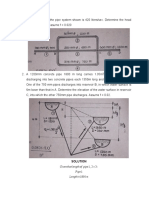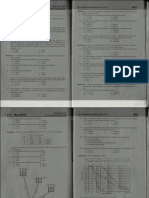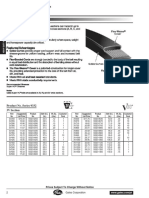100%(1)100% found this document useful (1 vote)
1K viewsHyd 6
Hyd 6
Uploaded by
Jocelyn Cabarles1. The document provides examples and explanations for calculating stresses in pipes and tanks carrying fluid pressures. It discusses calculating wall thickness, tensile stresses, hoop spacing, and forces for various hydraulic scenarios including stationary, horizontal and inclined motion conditions.
2. Nine practice problems are provided covering topics like pipe stresses, hoop forces, tank accelerations, fluid pressures, and inclined plane motion. Specific calculations are demonstrated for pipe diameters, head pressures, tensile stresses, spacing, accelerations, forces and fluid angles.
3. The solutions are given for problem 6 as 61 mm hoop spacing, problem 7 as 2256.3 kPa pressure, 9.2 mm wall thickness and 1015.3 kN tang
Copyright:
© All Rights Reserved
Available Formats
Download as PDF, TXT or read online from Scribd
Hyd 6
Hyd 6
Uploaded by
Jocelyn Cabarles100%(1)100% found this document useful (1 vote)
1K views2 pages1. The document provides examples and explanations for calculating stresses in pipes and tanks carrying fluid pressures. It discusses calculating wall thickness, tensile stresses, hoop spacing, and forces for various hydraulic scenarios including stationary, horizontal and inclined motion conditions.
2. Nine practice problems are provided covering topics like pipe stresses, hoop forces, tank accelerations, fluid pressures, and inclined plane motion. Specific calculations are demonstrated for pipe diameters, head pressures, tensile stresses, spacing, accelerations, forces and fluid angles.
3. The solutions are given for problem 6 as 61 mm hoop spacing, problem 7 as 2256.3 kPa pressure, 9.2 mm wall thickness and 1015.3 kN tang
Original Description:
Source: RI
Copyright
© © All Rights Reserved
Available Formats
PDF, TXT or read online from Scribd
Share this document
Did you find this document useful?
Is this content inappropriate?
1. The document provides examples and explanations for calculating stresses in pipes and tanks carrying fluid pressures. It discusses calculating wall thickness, tensile stresses, hoop spacing, and forces for various hydraulic scenarios including stationary, horizontal and inclined motion conditions.
2. Nine practice problems are provided covering topics like pipe stresses, hoop forces, tank accelerations, fluid pressures, and inclined plane motion. Specific calculations are demonstrated for pipe diameters, head pressures, tensile stresses, spacing, accelerations, forces and fluid angles.
3. The solutions are given for problem 6 as 61 mm hoop spacing, problem 7 as 2256.3 kPa pressure, 9.2 mm wall thickness and 1015.3 kN tang
Copyright:
© All Rights Reserved
Available Formats
Download as PDF, TXT or read online from Scribd
Download as pdf or txt
100%(1)100% found this document useful (1 vote)
1K views2 pagesHyd 6
Hyd 6
Uploaded by
Jocelyn Cabarles1. The document provides examples and explanations for calculating stresses in pipes and tanks carrying fluid pressures. It discusses calculating wall thickness, tensile stresses, hoop spacing, and forces for various hydraulic scenarios including stationary, horizontal and inclined motion conditions.
2. Nine practice problems are provided covering topics like pipe stresses, hoop forces, tank accelerations, fluid pressures, and inclined plane motion. Specific calculations are demonstrated for pipe diameters, head pressures, tensile stresses, spacing, accelerations, forces and fluid angles.
3. The solutions are given for problem 6 as 61 mm hoop spacing, problem 7 as 2256.3 kPa pressure, 9.2 mm wall thickness and 1015.3 kN tang
Copyright:
© All Rights Reserved
Available Formats
Download as PDF, TXT or read online from Scribd
Download as pdf or txt
You are on page 1of 2
Review Innovations CE Review for Nov 2022 - Hydraulics 6
HOOP AND CIRCUMFERENTIAL STRESSES ah
(HOOP TENSION) tan
g av
1. Walls Carrying Stress in Pipes and Tanks
Use (+) sign for upward motion and (-) sign for downward
pD motion.
t
2S t (eff)
VERTICAL MOTION
t = thickness of the wall (mm)
D = inside diameter (mm)
p = unit pressure of fluid (MPa)
St = actual or allowable tensile stress in the wall (MPa)
eff = efficiency of the connections
Note: If efficiency of connections is not mentioned in the
problem, assume 100% efficiency
2. Hoops Carrying Stress in Pipes and Cylindrical
Tanks
2T
S
pD
S = center to center spacing of the hoops (mm)
a
T = tensile force in one hoop (N) p h 1
g
MOVING VESSEL Use (+) sign for upward motion and (-) sign for downward
motion. Also note that a is positive for acceleration and
Horizontal Motion negative for deceleration.
1. A 10 mm thick steel pipe with inside diameter of 600
mm conveys water under a head of 480 m.
a. What is the tensile stress in the pipe in MPa?
b. What is the stress in the pipe wall if the head is
increased to 500 meters of water?
c. What is the required thickness under a head of
500 meters if the allowable tensile stress of the
pipe is 118 MPa and assuming that the joints are
80% efficient?
a 2. A 1.2-m Ø wood-stave pipe carries 76 m of water. It
tan
g is provided with 25-mm Ø steel hoops with an
allowable tensile stress of 104.3 MPa.
a. What pressure of water will be resisted by the
Inclined Motion hoops?
b. What is the actual tensile force in the hoops if
they are spaced at 75 mm center to center?
c. What spacing of the hoops will be
implemented?
3. An open tank 3 m long, 1.80 m wide, and 1.50 m high
contains water to a depth of 1.20 m. It is moving
parallel to a pair of longest sides. Determine the
following:
a. the maximum acceleration without spilling any
liquid.
b. the unbalanced force causing the acceleration in
part (1)?
Manila FB: @ReviewInnovationsOfficial Davao FB: Review Innovations Davao Branch
(02) 8735-9161 0919-227-9194 (082) 221-1121 0930-256-0998
Review Innovations CE Review for Nov 2022 - Hydraulics 6
c. the volume of water spilled if accelerated at 3
m/s2?
d. the volume of water retained when accelerated
at 5.4 m/s2?
4. A closed tank 2.4 m long, 1.2 m wide and 1.4 m high
contains water 1.1 m deep. A small hole is located
near the center of the cover. It moves in the direction
parallel to the 2.4-m dimension.
a. Determine the acceleration needed so that the
water surface will just touch the bottom of the
front wall.
b. Determine the pressure at the bottom of the rear
wall.
c. Determine the force of water acting on the top
of the tank.
d. Determine the total force acting on the bottom
of the tank.
5. An open circular cylinder with 2 m of water is acted
by an unbalanced upward force of 20 kN. The
volume of water inside the cylinder is 6.28 m3.
a. Compute the acceleration of the tank.
b. Compute the pressure at the bottom of the tank.
c. Calculate the force on the bottom of the tank.
6. A wood-stave pipe carries water under a head of 115
m. It is bound by 20-mm Ø steel hoops having an
allowable tensile stress of 98 MPa. Calculate the
required spacing of the hoops if the pipe’s inside
diameter is 90 cm.
7. A steel pipe having a diameter of 0.90 m carries water
under a head of 230 m of water.
a. Compute the internal pressure on the pipe.
b. Compute the required wall thickness if the
allowable stress for steel pipe is 110 MPa.
c. Compute the tangential force on the steel pipe.
8. A closed cylindrical tank is 2.4 m in diameter and 7.5
m long is completely filled with gasoline (sg = 0.90).
The tank, with its long axis horizontal, is pulled by a
truck along a horizontal surface.
a. Determine the pressure difference between the
ends (along the long axis of the tank) when the
truck undergoes an acceleration of 1.5 m/s2.
b. Determine the force on the front wall.
c. Determine the force on the rear wall.
9. An open vessel of water accelerates up a 25° plane at
2.5 m/s2.
a. What is the horizontal component of the
acceleration?
b. What is the vertical component of the
acceleration?
c. What is the angle that the water surface makes
with the horizontal?
6) 61 mm
7) 2256.3 kPa, 9.2 mm, 1015.3 kN
8) 10.125 kPa, 47.9 kN, 93.7 kN
9) 2.27 m/s2, 1.06 m/s2, 11.8°
Manila FB: @ReviewInnovationsOfficial Davao FB: Review Innovations Davao Branch
(02) 8735-9161 0919-227-9194 (082) 221-1121 0930-256-0998
You might also like
- HYDRAULICSDocument33 pagesHYDRAULICSmammasddNo ratings yet
- Philippine Productivity Ratios Labour Manpower RateDocument66 pagesPhilippine Productivity Ratios Labour Manpower RateLauro Paniergo100% (1)
- Forces On Curved Surfaces 1Document13 pagesForces On Curved Surfaces 1Yours PamoreNo ratings yet
- Refresher Module 16 (GH8) - Geotechnical Engineering and HydraulicsDocument1 pageRefresher Module 16 (GH8) - Geotechnical Engineering and HydraulicsMadelyn OronosNo ratings yet
- HGE#003-Hydraulics Engineering 3Document3 pagesHGE#003-Hydraulics Engineering 3Kim Ryan PomarNo ratings yet
- CE Board Nov 2021 - Hydraulics - Set 8Document3 pagesCE Board Nov 2021 - Hydraulics - Set 8Lemuel Teope100% (1)
- Orca Share Media1561345296214Document3 pagesOrca Share Media1561345296214Solomon Risty CahuloganNo ratings yet
- Topic 8 - Load PatternDocument11 pagesTopic 8 - Load PatternKenny Cantila100% (1)
- Welded Simple Connection: Based On Block Shear Capacity ofDocument12 pagesWelded Simple Connection: Based On Block Shear Capacity ofhazelNo ratings yet
- Hydro Comprehensive Examination Without SolutionsDocument3 pagesHydro Comprehensive Examination Without SolutionsPatrik100% (1)
- Problem 1. Structural Design "CE Board Exam Nov. 1992Document2 pagesProblem 1. Structural Design "CE Board Exam Nov. 1992AlvinNo ratings yet
- Assessment Exam 02Document7 pagesAssessment Exam 02Andrea Magtuto100% (1)
- Water Surface Profiles: Correction FactorDocument6 pagesWater Surface Profiles: Correction FactorGerald OrtizNo ratings yet
- Home Entertainment InteriorsDocument140 pagesHome Entertainment InteriorsMendelsohn100% (1)
- MIDTERM Lesson 3 Pipe Connections and ReservoirDocument18 pagesMIDTERM Lesson 3 Pipe Connections and Reservoir1900651No ratings yet
- Refresher Module 04 - M6 - Intermodal Transportation SystemDocument1 pageRefresher Module 04 - M6 - Intermodal Transportation SystemKiki Do youNo ratings yet
- Given That Length of Pipe1, 2 3: Pipe 1 Length 1800 M: SolutionDocument4 pagesGiven That Length of Pipe1, 2 3: Pipe 1 Length 1800 M: SolutionDiecon Irish ArboledaNo ratings yet
- 05 - Fluid Mechanics & Hydraulics (For Printing)Document5 pages05 - Fluid Mechanics & Hydraulics (For Printing)Joshua PhilNo ratings yet
- Hpge Practice ProblemsDocument14 pagesHpge Practice ProblemsJayson Pagal100% (1)
- CE Board Nov 2020 - Hydraulics - Set 13Document1 pageCE Board Nov 2020 - Hydraulics - Set 13Justine Ejay MoscosaNo ratings yet
- Megareview Group Study 3 HGEDocument44 pagesMegareview Group Study 3 HGESt Peter Life Plan Chapel100% (1)
- Republic of The Philippines: Battery - 2Document4 pagesRepublic of The Philippines: Battery - 2Aileen AntipoloNo ratings yet
- May 2018 HgeDocument11 pagesMay 2018 HgeHarly Demegillo GabineteNo ratings yet
- 14.3332013AtterbergLimitsData BlankDocument18 pages14.3332013AtterbergLimitsData BlankMewnEProwtNo ratings yet
- Final Quiz Problems To Be MadeDocument16 pagesFinal Quiz Problems To Be MadeRyan ReyesNo ratings yet
- Chapter 22 Hudraulic and Energy Grade LinesDocument7 pagesChapter 22 Hudraulic and Energy Grade LinesNader AlaaNo ratings yet
- Republic of The Philippines: Engr. Jonathan C. BulagaoDocument4 pagesRepublic of The Philippines: Engr. Jonathan C. BulagaoMichael James ll BanawisNo ratings yet
- Solutions For Quiz 7: Problem 1-3Document6 pagesSolutions For Quiz 7: Problem 1-3Von Andrei Medina100% (1)
- Exercise Problems: Palara, Arman S. (Inc) SPL Ce 5BDocument23 pagesExercise Problems: Palara, Arman S. (Inc) SPL Ce 5BKristel LenonNo ratings yet
- RCD 2 (Neu)Document9 pagesRCD 2 (Neu)Paul RoqueNo ratings yet
- Kippap-Handout-Evaluation Exam 5Document6 pagesKippap-Handout-Evaluation Exam 5Michael MercadoNo ratings yet
- Week 4 - Column Interaction DiagramDocument8 pagesWeek 4 - Column Interaction DiagramMAYHAY, ADRIAN PAULNo ratings yet
- Hyd 3Document1 pageHyd 3Jocelyn CabarlesNo ratings yet
- RC 1Document5 pagesRC 1Mayya BonaNo ratings yet
- Mata Deseree Plate 7Document9 pagesMata Deseree Plate 7Diecon Irish ArboledaNo ratings yet
- BesaaDocument55 pagesBesaaBenjamin Benicarlo Juanillo III100% (1)
- Simply Supported Beam With Support Added at Midspan To Prevent Excessive DeflectionDocument2 pagesSimply Supported Beam With Support Added at Midspan To Prevent Excessive DeflectionShiela Gonzales0% (1)
- Title: Properties of Steel Self Learning Assessment (Problem Set)Document14 pagesTitle: Properties of Steel Self Learning Assessment (Problem Set)Migaea AndresNo ratings yet
- Lesson 1Document3 pagesLesson 1Online Review Specialists0% (1)
- Answer Key - HydraugeoDocument5 pagesAnswer Key - HydraugeoBryan YuNo ratings yet
- Preboard MsteDocument6 pagesPreboard MsteWinter DeeneNo ratings yet
- Apr 2024 Preboard 1 HgeDocument3 pagesApr 2024 Preboard 1 HgeChrisjohn Dela Cruz100% (1)
- SM225 Module 2 Normal StressDocument6 pagesSM225 Module 2 Normal StressJustine IanNo ratings yet
- Algebra 6Document2 pagesAlgebra 6Christian PagsssNo ratings yet
- Sedc RefresherDocument56 pagesSedc RefresherHarold GarciaNo ratings yet
- Final Sec MathalinoDocument51 pagesFinal Sec MathalinoShiela GonzalesNo ratings yet
- Lesson 5.1 - Shear Strength in BeamsDocument12 pagesLesson 5.1 - Shear Strength in BeamsManibog April MaeNo ratings yet
- Kippap-Handout-MSTE (05 Probability and Statistics)Document2 pagesKippap-Handout-MSTE (05 Probability and Statistics)NaniNo ratings yet
- Properties of Fluids: Unit 1Document52 pagesProperties of Fluids: Unit 1Prince Arc MiguelNo ratings yet
- Sec Module 02Document15 pagesSec Module 02kenji belanizo50% (2)
- CE Module 19 - Buoyancy (Answer Key)Document4 pagesCE Module 19 - Buoyancy (Answer Key)Angelice Alliah De la Cruz100% (2)
- Hydrau Geotech Focusproblems3 2019Document7 pagesHydrau Geotech Focusproblems3 2019kim100% (1)
- Steel Design 8 Nov 2020Document1 pageSteel Design 8 Nov 2020Justine Ejay MoscosaNo ratings yet
- HYDRAULICS TOPIC 1 FLUID PROPERTIES UNIT PRESSURE 23 May 2022Document41 pagesHYDRAULICS TOPIC 1 FLUID PROPERTIES UNIT PRESSURE 23 May 2022samera salihNo ratings yet
- CE Module 20 - Relative Equilibrium (Answer Key)Document5 pagesCE Module 20 - Relative Equilibrium (Answer Key)Angelice Alliah De la CruzNo ratings yet
- Republic of The Philippines: Engr. Jonathan C. BulagaoDocument5 pagesRepublic of The Philippines: Engr. Jonathan C. BulagaoMichael James ll BanawisNo ratings yet
- Open ChannelsDocument21 pagesOpen ChannelsShlomo GoldbergsteinNo ratings yet
- (01-29) Hydraulics 6Document2 pages(01-29) Hydraulics 6Ram CaniculaNo ratings yet
- CE Board Nov 2021 - Hydraulics - Set 6Document2 pagesCE Board Nov 2021 - Hydraulics - Set 6Lemuel TeopeNo ratings yet
- Hyd 13Document2 pagesHyd 13eufemiorodolfoNo ratings yet
- Optimal Pipe Support SpansDocument4 pagesOptimal Pipe Support Spansmih1No ratings yet
- Lab 16 - Hydrostatic Forces and WorkDocument9 pagesLab 16 - Hydrostatic Forces and WorkMike JawNo ratings yet
- Surveying 4Document2 pagesSurveying 4Jocelyn CabarlesNo ratings yet
- Refresher - Geo - 5 - Nov - 2022-Policarpio 2Document2 pagesRefresher - Geo - 5 - Nov - 2022-Policarpio 2Jocelyn CabarlesNo ratings yet
- Hyd 13Document2 pagesHyd 13Jocelyn CabarlesNo ratings yet
- I MB V: CE Review For Nov 2022 - Hydraulics 4Document2 pagesI MB V: CE Review For Nov 2022 - Hydraulics 4Jocelyn CabarlesNo ratings yet
- Total Hydrostatic Pressure: P Ha I e AyDocument2 pagesTotal Hydrostatic Pressure: P Ha I e AyJocelyn Cabarles100% (1)
- Hyd 3Document1 pageHyd 3Jocelyn CabarlesNo ratings yet
- Base Units, Properties of Fluids, and Unit Pressures: CE Review For Nov 2022 - Hydraulics 1Document1 pageBase Units, Properties of Fluids, and Unit Pressures: CE Review For Nov 2022 - Hydraulics 1Jocelyn CabarlesNo ratings yet
- GitFlow GuidelinesDocument3 pagesGitFlow GuidelinesMona Ra0% (1)
- Chapter 4 - IfEDocument54 pagesChapter 4 - IfEKryzthina Andrea MaximoNo ratings yet
- Ica EceDocument65 pagesIca EceSravanthiVelagapudiNo ratings yet
- 1.1 Introduction and MotivationDocument93 pages1.1 Introduction and MotivationAnand AnajiNo ratings yet
- 10Document30 pages10Chaxa'nx Guzfik D'uzuraiky100% (1)
- Internal BP Meeting NotesDocument4 pagesInternal BP Meeting NotesThe GuardianNo ratings yet
- Lecture Notes On Mar 862-PpDocument349 pagesLecture Notes On Mar 862-PpViolet PellyNo ratings yet
- Dash 8 CH14Document58 pagesDash 8 CH14soufiane jouadiNo ratings yet
- Steffel Materials CatalogueDocument150 pagesSteffel Materials CatalogueAlvaro AguinagaNo ratings yet
- Case StudyDocument57 pagesCase StudyAr Ankit Khokher50% (10)
- Avtron IR Bullet CCTV Camera AA 4545P FSR3Document2 pagesAvtron IR Bullet CCTV Camera AA 4545P FSR3Avtron TechnologiesNo ratings yet
- Business Improvement Proposal by Fiona PDFDocument26 pagesBusiness Improvement Proposal by Fiona PDFChollada TontanasutthivongNo ratings yet
- Ci-Sppe2302-Intake 2017 Newtemplete 2020Document8 pagesCi-Sppe2302-Intake 2017 Newtemplete 2020tahik muNo ratings yet
- ECE569 16S hw5Document2 pagesECE569 16S hw5Binay PrasadNo ratings yet
- BS Iso 16063-1-1998+a1-2016 - (2018-01-19 - 01-28-23 PM) PDFDocument30 pagesBS Iso 16063-1-1998+a1-2016 - (2018-01-19 - 01-28-23 PM) PDFKrit JiamjirochNo ratings yet
- Zener Diode Tester: A B C D EDocument1 pageZener Diode Tester: A B C D EvalidaeNo ratings yet
- Heavyduty BeltsDocument60 pagesHeavyduty BeltsdauodNo ratings yet
- Pasteurizer Recorder and Recorder Controller: C1950 (STLR & HTST)Document8 pagesPasteurizer Recorder and Recorder Controller: C1950 (STLR & HTST)Mer ryNo ratings yet
- Role of Teachers' Sttitude in Remedial Teaching - ChidambaramDocument10 pagesRole of Teachers' Sttitude in Remedial Teaching - ChidambaramradhajagmohanNo ratings yet
- Final ReportDocument110 pagesFinal ReportGurpal kaur100% (1)
- Recognizing Arabic Handwritten Script USIng SVMDocument6 pagesRecognizing Arabic Handwritten Script USIng SVMPrasad RudrawarNo ratings yet
- MD Pappu Islam: Statement of Account Savings Bank DepositsDocument2 pagesMD Pappu Islam: Statement of Account Savings Bank DepositsJeryNo ratings yet
- Fundamentals of PAUT - 22-24Document3 pagesFundamentals of PAUT - 22-24Kevin HuangNo ratings yet
- Exergy Analysis of Organic Rankine CycleDocument9 pagesExergy Analysis of Organic Rankine CycleMukul GoyalNo ratings yet
- FM Question BankDocument2 pagesFM Question BankAthish RaswanthNo ratings yet
- Hydraulic Bench OperationDocument2 pagesHydraulic Bench OperationAneeqMustafa GhumroNo ratings yet
- Land RigDocument11 pagesLand RigLala KamarudheenNo ratings yet
- MGMT510 Collection of Old PapersDocument6 pagesMGMT510 Collection of Old Paperscs619finalproject.comNo ratings yet































































































